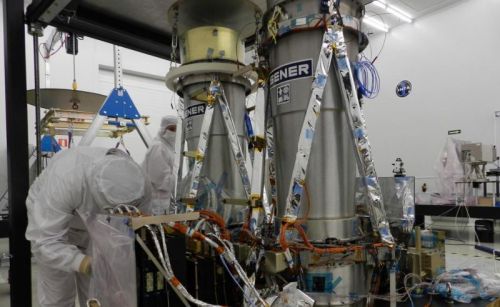
26/01/2017
SENER, 50 Years In Space!
SENER, 50 Years In Space!
The SENER international engineering and technology group with Catalan headquarters in the Barcelona Synchrotron Park (BSP) celebrates its 50th year working in space. The launchers tower project in Kiruna, Sweden, was the first Space project that was tendered for in Spain, and it was SENER that did it, in 1967. This project clearly heralded starting point for SENER’s career in the space sector.
Since then, SENER currently had about 300 devices and subsystems in different satellites and space vehicles for agencies from the US (NASA), Europe (ESA), Japan (JAXA) and Russia (Roscosmos). Among the more recent projects, some famous missions can be mentioned: Rosetta (2004), Herschel & Planck (2009), Curiosity (2011), Gaia (2013), LISA Pathfinder (2015) or ExoMars 2020.
In the 4 worldwide centers where SENER carries out its space projects (BSP in Barcelona, Bilbao and Madrid, Spain, and Warsaw, Poland), SENER provides engineering and production services in electromechanical components and systems, guidance, navigation and control, and attitude and orbit control systems, optical system and microgravity and life support systems.
Regarding SENER future, Space and Defense director Diego Rodríguez said in a recent interview that “our mission now is to continue to supply subsystems for the flight segment while aiming for other areas, such as launchers, and branching out to projects with a lower institutional profile and a clear commercial focus”.
As part of the different activities that will be carried out to celebrate these 50 years in space, SENER organizes the so-called “Star trajectory” comic strip contest. Participants must present by February 3 a one-page color draft (portrait or landscape A4 size) with 3 to 9 drawings, free technique, in Spanish, original and unpublished (more information in Spanish here).
Since then, SENER currently had about 300 devices and subsystems in different satellites and space vehicles for agencies from the US (NASA), Europe (ESA), Japan (JAXA) and Russia (Roscosmos). Among the more recent projects, some famous missions can be mentioned: Rosetta (2004), Herschel & Planck (2009), Curiosity (2011), Gaia (2013), LISA Pathfinder (2015) or ExoMars 2020.
In the 4 worldwide centers where SENER carries out its space projects (BSP in Barcelona, Bilbao and Madrid, Spain, and Warsaw, Poland), SENER provides engineering and production services in electromechanical components and systems, guidance, navigation and control, and attitude and orbit control systems, optical system and microgravity and life support systems.
Regarding SENER future, Space and Defense director Diego Rodríguez said in a recent interview that “our mission now is to continue to supply subsystems for the flight segment while aiming for other areas, such as launchers, and branching out to projects with a lower institutional profile and a clear commercial focus”.
As part of the different activities that will be carried out to celebrate these 50 years in space, SENER organizes the so-called “Star trajectory” comic strip contest. Participants must present by February 3 a one-page color draft (portrait or landscape A4 size) with 3 to 9 drawings, free technique, in Spanish, original and unpublished (more information in Spanish here).
More news
18/06/2020
Eurecat, at the cutting edge of plastronics
03/06/2020
Barcelona will be connected to one of the longest subsea fiber optic cable in the world
20/05/2020
Hub B30: a useful platform
07/05/2020
We are a territory of innovation
16/04/2020
Alba synchrotron: the double life of electrons
02/04/2020
Alba synchrotron: 10 years at the service of the society









